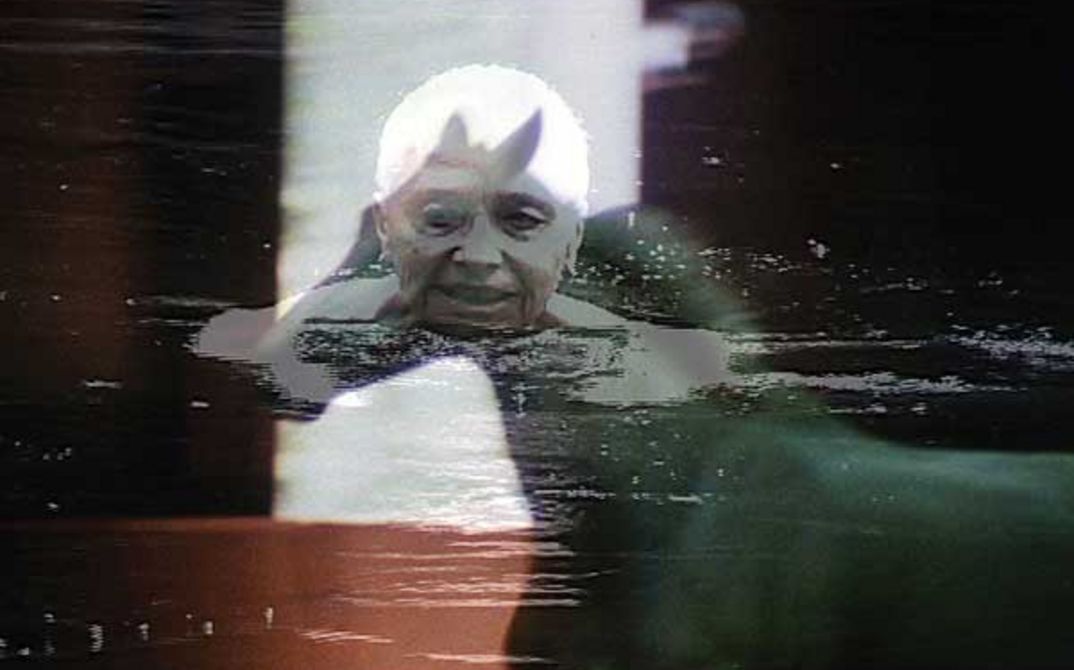A Horse Is Not A Metaphor
Filmmaker Barbara Hammer fights ovarian cancer with visions of horseback riding and river swimming in her new experimental film, A Horse Is Not A Metaphor.
As a "cancer thriver" rather than "survivor", Barbara Hammer rides the red hills of Georgia O'Keefe's Ghost Ranch in New Mexico, the grassy foothills of the Big Horn in Wyoming, and leafy paths in Woodstock, New York, changing illness into recovery.
The haunting and wondrous music of Meredith Monk underscores and celebrates in this experiential/experimental film that lifts us up when we might be most discouraged.
USA 2008, video, 30 minutes;
Still Point
Still Point whirls around a point of centeredness as four screens of home and homelessness, travel and weather, architecture and sports signify the constant movement and haste of late twentieth century life.
USA 1989, 16mm, 8 minutes
Sanctus
Sanctus uses the moving x-rays shot by Dr. James Sibley Watson (Fall of the House of Usher, 1929 and Lot in Sodom, 1933) and his colleagues in the 1950s. Making the invisible visible, the film reveals the skeletal structure of the human body as it protects the hidden fragility of interior organ systems.
USA 1990, 16mm, 19 minutes; score: Neil B. Rolnick
Vital Signs
Vital Signs, 1991, a multi-media collage film/video challenges Western constructions of death as horrible and fearful by reversing this ideology. Instead of fear or aversion, death, in the form of a skeleton is embraced, fed, clothed, walked with and made love to.
By embracing death in a public place, by performance in a college courtyard, by coming a variety of mediums, the hidden sutures of form and the displacement of this significant life process, death, are revealed.
USA 1991, 16mm, 9 minutes
Changing the Shape of Film: Available Space & Bent Time
Two film performances reprised from 1979-1983 (2009)
Available Space
"In Available Space I push the limits of restriction in eight different sections and eight different ways. Who determined that film should be projected upon a rectangular white reflective screen? What would happen if this formula were challenged? If the projector moved and the audience had to move to see the film? Available Space is a film made for performance on a 360 degree rotary projection table. The potential of boundaries are confused, change context and create a new relationship between film and spectator suggesting interactive play. Available space explores the relationship of architectural space to image and to the limits of the projector's beam. This was the beginning film in a series of attempts to empower, activate, make blood rush through the veins' of the viewing public."
Barbara Hammer
This film performance is reprised from 1979 where it screened at A Space, Toronto and in1980 at New Langton Arts, San Francisco and Franklin Furnace, New York City.
Bent Time
A round translucent screen, an inflated weather balloon provides another form for activating the audience. To see the film spectators move around and under the screen. The audience movement creates multiple viewpoints as the image curves and bends.
The soundtrack is Rattlesnake Mountain, an original score by Pauline Oliveros.
Film scrolls
"These scrolls were made from the source material of 6 inches of 16mm film I had treated with nitrate acid, salt crystals, and numerous paints. Alfred University, New York, selected me for an Artist’s Residency for a week and where I used their digital printing facilities. When I heard they had an Epson Printer that printed from a roll of photo paper that was archival I decided to make the scrolls."
Barbara Hammer
Barbara Hammer was born on May 15, 1939 in Hollywood, California. She is a visual artist working primarily in film and video and has made over 80 works in a career that spans 30 years. She is considered a pioneer of queer cinema. Her experimental films of the 1970s often dealt with taboo subjects such as menstruation, female orgasm and lesbian sexuality. In the '80s she used optical printing to explore perception and the fragility of 16mm film life itself. Optic Nerve (1985) and Endangered (1988) were selected for the Whitney Museum of American Art Biennials ('85, '89), Nitrate Kisses (1992) for the 1993 Whitney Biennial. Her documentaries tell the stories of marginalized peoples who have been hidden from history and are often essay films that are multi-leveled and engage audiences viscerally and intellectually with the goal of activating them to make social change.
She lives and works in New York City.
